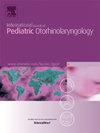Risk factors associated with epistaxis in children
IF 1.2
4区 医学
Q3 OTORHINOLARYNGOLOGY
International journal of pediatric otorhinolaryngology
Pub Date : 2025-06-14
DOI:10.1016/j.ijporl.2025.112427
引用次数: 0
Abstract
Objective
Epistaxis in children has been associated with climate change and temperature variations. The objective of this study is to evaluate various risk factors for pediatric epistaxis.
Methods
Retrospective case control study of all pediatric patients presenting to our clinic between August 2020 and February 2024 was performed. Cases were children presenting for epistaxis. Controls were all other children presenting for various rhinologic disorders. Patients’ characteristics, comorbidities, and date of visits were reviewed. Children with chronic rhinosinusitis (CRS), those with known bleeding disorders, and those on antiplatelets or anticoagulation therapy were excluded.
Results
A total of 332 children were included, 98 patients with epistaxis and 234 control children. There was no difference in age, gender, allergy status, or nasal septal deviation between children with epistaxis and controls. Children with epistaxis were more likely to present in the winter season (p = 0.013), and less likely to be on intranasal corticosteroid spray (INCS) (p = 0.003). Multivariate logistic regression demonstrated an increased risk of epistaxis associated with seasonality [OR = 1.79, 95 % CI = 1.07–2.99] and a decreased risk of epistaxis associated with INCS use [OR = 0.19, 95 % CI = 0.06–0.66].
Conclusion
Epistaxis in children is mostly associated with cold seasons. The use of INCS seems to be associated with a decreased risk of epistaxis. Other factors such as allergic rhinitis, nasal septal deviation, gender, or age do not increase the risk of epistaxis in children.
儿童鼻出血的相关危险因素
目的儿童鼻出血与气候变化和温度变化有关。本研究的目的是评估儿童鼻出血的各种危险因素。方法对2020年8月至2024年2月在我院就诊的所有儿科患者进行回顾性病例对照研究。病例为儿童,表现为鼻出血。对照组为其他所有表现为各种鼻内科疾病的儿童。回顾了患者的特征、合并症和就诊日期。排除慢性鼻窦炎(CRS)患儿、已知出血性疾病患儿和接受抗血小板或抗凝治疗的患儿。结果共纳入患儿332例,其中鼻出血患儿98例,对照组234例。鼻衄患儿与对照组在年龄、性别、过敏状况或鼻中隔偏曲方面无差异。鼻出血的儿童更可能出现在冬季(p = 0.013),鼻内皮质类固醇喷雾剂(INCS)的可能性较小(p = 0.003)。多因素logistic回归显示,鼻出血风险增加与季节性相关[OR = 1.79, 95% CI = 1.07-2.99],鼻出血风险降低与使用INCS相关[OR = 0.19, 95% CI = 0.06-0.66]。结论儿童鼻出血多与寒冷季节有关。使用INCS似乎与鼻出血的风险降低有关。其他因素如过敏性鼻炎、鼻中隔偏曲、性别或年龄不会增加儿童鼻出血的风险。
本文章由计算机程序翻译,如有差异,请以英文原文为准。
求助全文
约1分钟内获得全文
求助全文
来源期刊
CiteScore
3.20
自引率
6.70%
发文量
276
审稿时长
62 days
期刊介绍:
The purpose of the International Journal of Pediatric Otorhinolaryngology is to concentrate and disseminate information concerning prevention, cure and care of otorhinolaryngological disorders in infants and children due to developmental, degenerative, infectious, neoplastic, traumatic, social, psychiatric and economic causes. The Journal provides a medium for clinical and basic contributions in all of the areas of pediatric otorhinolaryngology. This includes medical and surgical otology, bronchoesophagology, laryngology, rhinology, diseases of the head and neck, and disorders of communication, including voice, speech and language disorders.

 求助内容:
求助内容: 应助结果提醒方式:
应助结果提醒方式:


